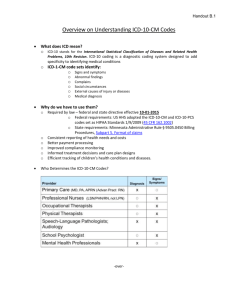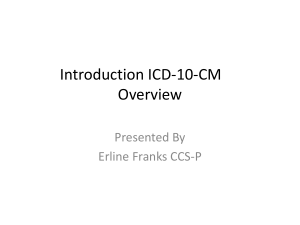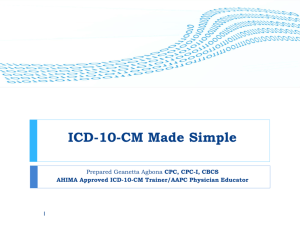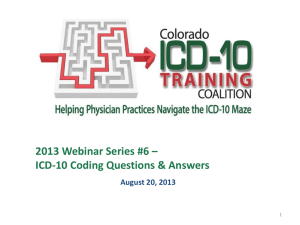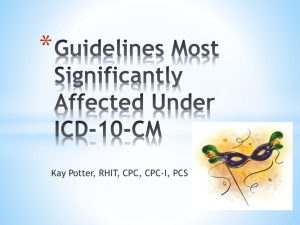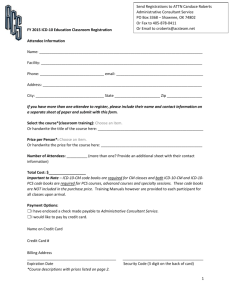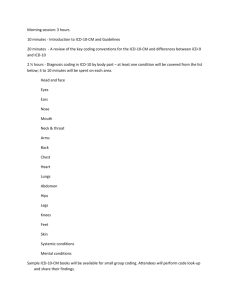ICD-10-CM and ICD-10
advertisement
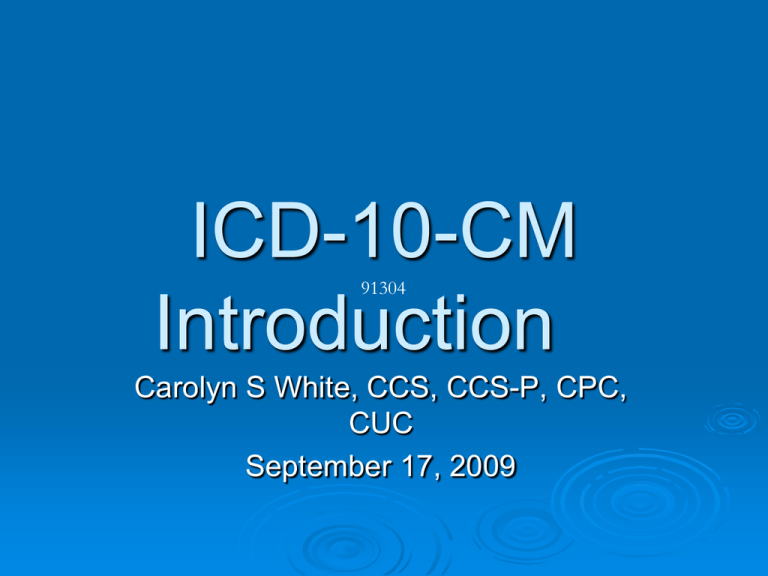
ICD-10-CM Introduction 91304 Carolyn S White, CCS, CCS-P, CPC, CUC September 17, 2009 Overview Status, Why?, What? Overview of differences/similarities Relationship between increased clinical detail needed for increased anatomy/physiology knowledge and improved documentation 2 Status of ICD-10-CM Adoption In August of 2008, the Centers for Medicare and Medicaid Services (CMS) issued a notice of proposed rule making (NPRM) that would replace the ICD-9-CM code set now used to report health care diagnosis and procedures with the greatly expanded ICD-10-CM and ICD10-PCS code sets. The implementation date will not be before 2011. What Is ICD-10-CM? Clinical modification of the World Health Organization’s ICD-10, ICD-10-CM includes the level of detail needed for morbidity classification and diagnostic specificity. As with ICD-9-CM, ICD-10-CM is maintained by the National Center for Health Statistics. Development of ICD-10 Goals of the tenth revision: Expand the content, purpose, and scope of the system Include ambulatory care services Increase clinical skills Capture risk factors in primary care Identify emergent diseases Group diagnoses for epidemiological purposes Why ICD-10-CM? ICD-9-CM is outdated and obsolete due to HIPAA’s requirements for electronic transactions ICD-9-CM was originally designed for indexing purposes; now, also being used for reimbursement. Enhance the efficiency of clinical data collection and the quality of administrative data. Benefits of ICD-10-CM Provides greater specificity, Allows the possibility of greater expansion of codes. Extends beyond classification of diseases and injuries to include risk factors in a primary care setting. Benefits of ICD-10 (Continued) Includes recently identified diseases. Updates general terminology and disease classification to be consistent with accepted and current clinical practice. Provides more detailed information to providers, payers, and policy makers. Improvements in ICD-10-CM Conditions are grouped more logically. Subcategory titles are more complete. Fifth- and sixth-character subclassifications are incorporated into codes. Laterality of conditions is incorporated at the fifth- and sixth-character levels. Specificity has been increased. Extensions provide more information. What Is ICD-10-CM? The system consists of more than 68,000 codes, compared to approximately 13,000 ICD-9-CM codes. ICD-10-CM codes have the potential to reveal more about quality of care, ICD-10-CM incorporates greater specificity and clinical detail to provide information for clinical decision making and outcomes research. What Is ICD-10-CM? ICD-10-CM codes may consist of up to seven digits, with the seventh digit extensions representing visit encounter or sequelae for injuries and external causes. The difference in code structure is shown in the figure above. ICD-9-PCS ICD-10-PCS is a procedural coding system developed under contract by the Center for Medicare & Medicaid Services (CMS) Replacement of the ICD-9-CM procedural coding system for hospital reporting of inpatient procedures. 7-character alphanumeric code structure. Brief Comparison of ICD-10-CM with ICD-9-CM General/overall improvements: ICD-10-CM codes are alphanumeric and include all letters except U. ICD-9-CM’s V and E codes are incorporated into the main classification in ICD-10-CM. Maximum length of codes in ICD-10-CM is seven characters. ICD-10-CM offers information relative to ambulatory and managed care encounters. Comparing ICD-9-CM and ICD-10-CM Similarities in Structure and Terms ICD-10-CM has the same type of hierarchy in its structure as ICD-9-CM. All codes have the same first three digits describing common traits, each character beyond the first three providing more specificity ICD-10-CM Structure ICD-10-CM has an index and tabular list similar to those of ICD-9-CM. ICD-10-CM index is much longer. As with ICD-9-CM, ICD-10-CM uses an indented format for both the index and tabular list. Categories, subcategories, and codes are contained in the tabular list Organizational Changes While ICD-10-CM has the same type of hierarchical structure as ICD-CM, some differences in organization: ICD-10-CM consists of 21 chapters. Some chapters include the addition of a sixth character. ICD-10-CM includes full code titles for all codes (no references back to common fourth and fifth digits). V and E codes are no longer supplemental classifications. Organizational Changes Sense organs have been separated from nervous system disorders. Injuries are grouped by anatomical site rather than injury category. Postoperative complications have been moved to procedure-specific body system chapter. New Features ICD-10-CM has numerous new features allowing for greater level of specificity Combination codes for conditions and common symptoms or manifestations Combination codes for poisonings and external causes Added laterality New Features Added extensions for episode of care Expanded codes (injury, diabetes, alcohol/substance abuse, postoperative complications) Inclusion of trimester in obstetrics codes and elimination of fifth digits for episode of care New Features Expanded detail relevant to ambulatory and managed care encounters Changes in timeframes specified in certain codes External cause codes no longer a supplementary classification Inclusion of trimester in obstetrics codes and elimination of fifth digits for episode of care New Features Expanded detail relevant to ambulatory and managed care encounters Changes in timeframes specified in certain codes External cause codes no longer a supplementary classification New Feature An additional feature is the expansion of codes for certain conditions. Two examples are diabetes mellitus and postoperative complication codes. New Features—Diabetes Diabetes mellitus codes are expanded to include the classification of the diabetes and the manifestation. The category for diabetes mellitus has been updated to reflect the current clinical classification of diabetes No longer classified a controlled or uncontrolled: New Features--Diabetes E08.22, Diabetes mellitus due to an underlying condition with diabetic chronic kidney disease E09.52, Drug or chemical induced diabetes mellitus with diabetic peripheral angiopathy with gangrene E10.11, Type 1 diabetes mellitus with ketoacidosis with coma E11.41, Type 2 diabetes mellitus with diabetic mononeuropathy New Features--Complications ICD-10-CM provides 50 different codes for “complications of foreign body accidently left in body following a procedure,” compared to only one code in ICD-9-CM. Examples include: (next) New Features--Complications T81.535, Perforation due to foreign body accidently left in body following heart catheterization T81.530, Perforation due to foreign body accidently left in body following surgical operation T81.524, Obstruction due to foreign body accidently left in body following endoscopic examination New Features- Fracture Extensions Code extensions (seventh character) have been added for injuries and external causes to identify the encounter: A Initial encounter D Subsequent encounter S Sequelae Fracture codes require a seventh character that identifies if the fracture is open or closed for an initial encounter or if a subsequent encounter is for routine healing, delayed healing, nonunion, malunion, or sequelae. The fracture extensions are: A Initial encounter for closed fracture B Initial encounter for open fracture D Subsequent encounter for fracture with Laterality in Fracture Coding G Subsequent encounter for fracture with delayed healing K Subsequent encounter for fracture with nonunion P Subsequent encounter for fracture with malunion S Sequelae An example is code S42.321A, Displaced transverse fracture of shaft of humerus, right arm, initial encounter for closed fracture. ICD-10-CM Code Examples ICD-10-CM consists of new features and greater specificity Combination Codes for Poisonings and the External Cause T39.011, Poisoning by aspirin, accidental (unintentional) T39.012, Poisoning by aspirin, intentional self harm T39.013, Poisoning by aspirin, assault T39.014, Poisoning by aspirin, undetermined ICD-10-CM Code Examples Combination Codes for Conditions and Common Symptoms I25.110, Arteriosclerotic heart disease of native coronary artery with unstable angina pectoris K50.013, Crohn’s disease of small intestine with fistula K71.51, Toxic liver disease with chronic active hepatitis with ascites ICD-10-CM Code Examples Laterality C50.212, Malignant neoplasm of upperinner quadrant of left female breast H02.835, Dermatochalasis of left lower eyelid I80.01, Phlebitis and thrombophlebitis of superficial vessels of right lower extremity L89.213, Pressure ulcer of right hip, stage III Coding System Changes CPT and HCPCS Level II will continue to be used for: Physician and other professional services Procedures performed in hospital outpatient departments and other outpatient facilities Improvements in ICD-10-CM Codes Etiologies and manifestations are grouped in combination codes. Code titles have been changed to reflect new technology and recent terminology. Codes have been added to describe postoperative or postprocedural conditions. Trimester specificity has been added. Many new codes have been added. Combination Codes Solve Sequencing Dilemmas A single code may be used to classify two diagnoses, a diagnosis with an associated sign or symptom, or a diagnosis with an associated complication. This allows one code to be assigned, resulting in fewer cases requiring more than one code and reducing sequencing problems Sequencing Dilemmas contd. Manifestation/etiology conditions require two codes with sequencing mandated by ICD-9-CM. Brackets in the index identified that the etiology (diabetes mellitus) code was sequenced before the manifestation (diabetic nephropathy). Sequencing Dilemmas contd In cases when ICD-9-CM did not indicate correct sequencing, coding was not clearcut, and Coding Clinic advice was needed to sequence conditions appropriately. The ICD-10-CM use of combination codes has greatly simplified this process Sequencing Dilemmas contd Combination codes are also available for external causes and poisonings, with information combined into one code (including the drug involved) making those difficult sequencing rules obsolete. Combination Code Examples Examples of these combination codes include: I25.110, Atherosclerotic heart disease of native coronary artery with unstable angina pectoris E10.21, Type 1 diabetes mellitus with diabetic nephropathy N30.01, Acute cystitis with hematuria T39.011A, Poisoning by aspirin, accidental (unintentional), initial encounter Full Descriptions Reduce CrossReferencing ICD-10-CM has made every attempt to write out the full code title for all codes, decreasing cross-references. This change provides greater comprehension of the meaning of the code, as well as facilitates computer applications. Choosing Sides with Laterality ICD-10-CM includes codes for laterality (unclassified in ICD-9-CM). Codes for left side, right side, and in some cases bilateral are available in appropriate chapters. If the side is not documented in the medical record, an unspecified side code is available. Choosing Sides with Laterality The majority of the affected codes are in the neoplasm and injury chapters. The classification of this information can be very beneficial in reporting claims for payment, Examples of these types of codes include: C50.511, Malignant neoplasm of lowerouter quadrant of right female breast M21.722, Unequal limb length (acquired), left humerus S72.344A, Nondisplaced spiral fracture of shaft of right femur, initial encounter for closed fracture Expanded Codes Capture More Detail Expanded codes are available in many sections of ICD-10-CM, particularly in the injury, diabetes, alcohol and substance abuse, and postoperative complication sections. Expanded Codes Capture More Detail There are five categories for diabetes in ICD-10-CM: E08, Diabetes due to underlying condition; E09, Drug or chemical induced diabetes; E10, Type 1 diabetes; E11, Type 2 diabetes; and E13, Other specified diabetes mellitus. Controlled or uncontrolled is not a classification in ICD-10-CM. Expanded Codes Injuries are grouped by body part rather than by categories of injury, so that all injuries of the specific site (such as head and neck) are grouped together rather than groupings of all fractures or all open wounds. Extensions Specify Encounter ICD-9-CM limitations have created challenges in assigning codes for specific aftercare encounters in the outpatient and postacute care settings. ICD-10-CM has added code alpha character extensions (seventh character) in appropriate sections to provide specific information about the characteristics of the encounter. Extensions Specify Encounter In the injury and external cause sections, the extension classifies an initial encounter, subsequent encounter, or sequelae of an encounter. Extensions have different meanings depending on the section, but common extensions are: Extensions Specify Encounter In A, Initial encounter D, Subsequent encounter S, Sequelae code S81.012, Laceration without foreign body, left knee, the seventh character would be A for an initial encounter, D for subsequent encounter, or S for sequelae. Structure of ICD-10-CM The international ICD-10 classification is published in three volumes: Volume 1: Tabular List Volume 2: Guidelines Volume 3: Alphabetic Index ICD-10-CM includes only two volumes: Volume 1: Tabular List Volume 2: Alphabetic Index ICD-10-CM Alphabetic Index The Alphabetic Index for ICD-10-CM is similar to the Alphabetic Index for ICD-9CM. The index is a list of terms related to diseases, disorders, conditions, poisonings and adverse effects, and external causes. The function of the index is to help users locate codes in the classification. Mapping Between Old and New General equivalency maps (GEMS) have been developed GEMS are not crosswalks—they are reference maps Backward & forward maps available on CMS website Between ICD9CM and ICD10PCS Between ICD9CM and ICD10CM Mapping Between Old and New Reimbursement map was added to the CMS website in 2009 Intended for use by payers as a temporary mechanism to allow claims to be processed by legacy systems until internal systems have been fully converted. Maps should not be used for coding Training for ICD-10-CM (Continued) Because ICD-10-CM coding requires a higher level of specificity than ICD-9-CM coding, experts and planners recommend users will need a strong background in anatomy and physiology, medical terminology, pharmacology, and medical science to apply the revised classification system. Learning the ICD-10-CM System National Center for Health Statistics Web site, http://www.cdc.gov/nchs/icd/icd10cm.htm ICD-10-CM Guidelines The ICD-10-CM index and tabular list were released in July 2007; the “Draft ICD-10CM Official Guidelines” were released in June 2003 (available at www.cdc.gov/nchs/data/icd9/draft_i10guideln.pdf). Monitor the National Center for Health Statistics Web site for any new versions of the guidelines, index, and tabular list before implementation. NCHS National Center for Health Statistics. “ICD-10CM Index and Tabular.” 2007. Available online at www.cdc.gov/nchs/about/otheract/icd9/icd10cm. htm. National Center for Health Statistics. “Draft ICD10-CM Official Guidelines.” 2003. Available online at www.cdc.gov/nchs/data/icd9/draft_i10guideln.pd f. References ICD-10-CM and ICD-10-PCS Preview, Anita Hazelwood, MLS, RHIA, FAHIMA, Carol A Venable, MPH, RHIA, FAHIMA AHIMA, 2009 ICD-10-CM and ICD-10-PCS Preview, Ann Barta, MSA, RHIA, AHIMA ICD-10-CM Field Testing Project, Report on Findings, AHA, AHIMA, September 23, 2003 References National Center for Health Statistics. “ICD-10CM Index and Tabular.” 2007. Available online at www.cdc.gov/nchs/about/otheract/icd9/icd10cm. htm. Article citation: Zeisset, Ann. "ICD-10-CM Enhancements: A Look at the Features That Will Improve Coding Accuracy" Journal of AHIMA 80, no.2 (February 2009): 55-58. References Barta, Ann; et al.. "ICD-10-CM Primer." Journal of AHIMA 79, no.5 (May 2008): 64-66.
